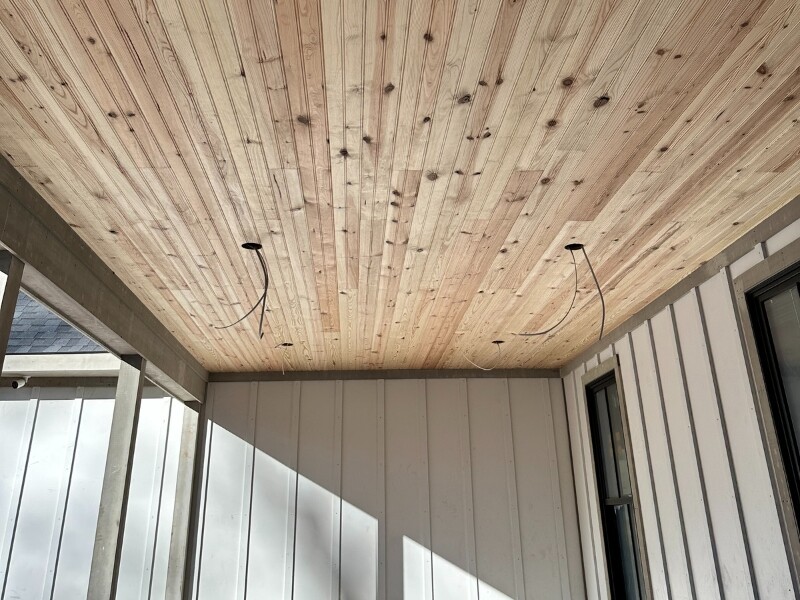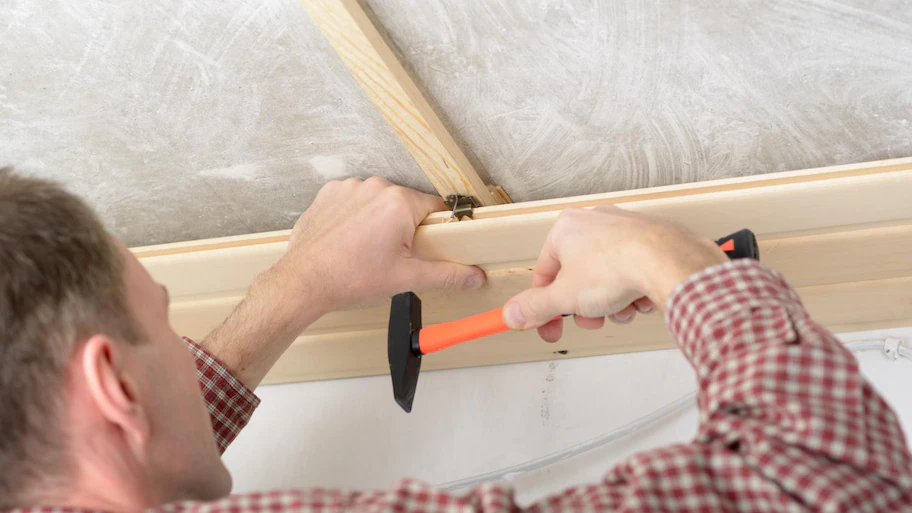When it comes to enhancing the interior of your home, few features offer the elegance, warmth, and timeless appeal of a White Pine Tongue and Groove Ceiling. Whether you’re renovating a room or designing a new space, this style of ceiling is a perfect way to add character and sophistication to your living environment. It combines the natural beauty of wood with a clean, polished look that complements both modern and traditional interiors.

This article will explore everything you need to know about White Pine Tongue and Groove Ceilings, including their benefits, design options, installation tips, and how to maintain them for years of enjoyment. Let’s dive into why this ceiling style is becoming increasingly popular in home design.
Read too: Bathroom Flooded Through the Ceiling: A Comprehensive Guide
What is a White Pine Tongue and Groove Ceiling?
A White Pine Tongue and Groove Ceiling refers to a ceiling made from white pine wood planks that are interlocked using the tongue and groove method. This means that each plank has a protruding “tongue” on one edge and a corresponding “groove” on the other. When the boards are installed, the tongue of one plank fits into the groove of the next, creating a seamless and sturdy surface.
White pine is a popular choice for this type of ceiling because of its light, natural color and attractive grain patterns. The White Pine Tongue and Groove Ceiling is particularly appreciated for its classic appeal, offering a rustic yet elegant aesthetic that fits well in a variety of home designs. From contemporary living rooms to cozy cabins, this ceiling style can transform the ambiance of any space.
Why Choose a White Pine Tongue and Groove Ceiling?
There are many reasons why a White Pine Tongue and Groove Ceiling can be the perfect addition to your home. Below, we’ll explore some of the most notable advantages:
1. Natural Beauty and Warmth
One of the standout features of a White Pine Tongue and Groove Ceiling is its inherent beauty. White pine wood has a soft, pale hue with light, creamy tones and subtle grain patterns, creating an inviting and airy atmosphere. This natural warmth can make any room feel more comfortable and welcoming.
2. Versatility in Design
Whether you’re going for a rustic, modern, or traditional look, White Pine Tongue and Groove Ceilings offer a high degree of flexibility in design. The clean lines of the tongue and groove system lend themselves to contemporary interiors, while the natural texture of the wood is perfect for country or farmhouse-style rooms. You can also finish the wood with a variety of stains, paints, or finishes to match your decor.
3. Increased Property Value
Installing a White Pine Tongue and Groove Ceiling can increase the value of your home by enhancing its overall aesthetic. The classic and elegant look of wood ceilings is often associated with high-end homes, which means prospective buyers may be more attracted to a property that has this feature.
4. Durability and Strength
White pine is a relatively strong and durable wood, making it ideal for ceilings that need to stand the test of time. The tongue and groove installation method adds strength and stability to the ceiling, helping to prevent warping, cracking, or shifting over time. The solid connection between each plank ensures that the ceiling will remain intact, even in areas that experience fluctuations in temperature and humidity.
5. Ease of Installation
Another benefit of a White Pine Tongue and Groove Ceiling is that it is relatively easy to install. Whether you choose to tackle the project yourself or hire a professional, the tongue and groove system simplifies the process. The interlocking planks make it easier to align and secure the boards to the ceiling, reducing the risk of gaps or unevenness.
Design Ideas for White Pine Tongue and Groove Ceilings
There are numerous ways to incorporate a White Pine Tongue and Groove Ceiling into your home. Below are some design ideas to inspire your next renovation project:
1. Rustic Cabin Charm
If you’re looking to achieve a cozy, cabin-inspired feel, a White Pine Tongue and Groove Ceiling is a perfect choice. Pair it with exposed wooden beams, stone accents, and warm furniture to create an inviting retreat. The light color of white pine creates a beautiful contrast against darker wooden accents, giving your space an authentic, rustic atmosphere.
2. Modern Minimalism
In contemporary homes, a White Pine Tongue and Groove Ceiling can bring a natural touch to minimalist designs. To achieve a clean and modern look, opt for a smooth, unfinished white pine ceiling. The subtle grain patterns will add texture without overwhelming the space, creating a calming and sophisticated environment.
3. Beachy Vibes
If you live near the coast or want to bring a beachy feel to your home, a White Pine Tongue and Groove Ceiling is a fantastic option. The pale wood tones mimic the look of driftwood and enhance the breezy, relaxed vibe of a coastal home. Combine it with light, airy furniture and coastal-inspired decor to create the perfect beach retreat.
4. Traditional Elegance
For those seeking a more classic or traditional look, a White Pine Tongue and Groove Ceiling can easily be incorporated into traditional spaces. Pair it with crown molding, wainscoting, and elegant chandeliers to create a sophisticated dining room or living area that exudes timeless charm.
5. Vaulted Ceilings
In homes with high or vaulted ceilings, a White Pine Tongue and Groove Ceiling can add depth and dimension to the room. The interlocking boards highlight the height of the ceiling, making the space feel grander and more open. To accentuate the beauty of the ceiling, consider adding pendant lights or chandeliers that draw attention to the architectural feature.
Installation Tips for White Pine Tongue and Groove Ceilings
Installing a White Pine Tongue and Groove Ceiling can be a rewarding DIY project if you’re up for the challenge. However, it’s essential to follow the right steps to ensure a professional-looking and durable installation. Here are some tips for a successful installation:
1. Prepare the Space
Before you begin installation, ensure that your ceiling is clean, level, and free from debris. Check for any cracks or damage that might affect the integrity of the ceiling. You should also take the time to measure the area to determine how much white pine material you’ll need.
2. Choose the Right Planks
Select high-quality White Pine Tongue and Groove planks that are free from defects or warping. Make sure the planks are appropriate for ceiling use, as ceiling boards are typically thinner and lighter than wall planks. Additionally, decide whether you want to install the planks in a horizontal or vertical orientation, as both offer different aesthetic effects.
3. Allow the Wood to Acclimate
Wood is sensitive to changes in humidity, so it’s essential to allow your White Pine Tongue and Groove planks to acclimate to the room before installation. Let the planks sit in the room where they will be installed for at least 48 hours, so they can adjust to the temperature and moisture levels.
4. Install the Planks
Begin by attaching the first row of planks to the ceiling, making sure they’re level. Use a nail gun or screws to secure the planks, driving the nails into the grooves to hide them from view. Continue installing the remaining planks, making sure the tongue and groove system locks together snugly as you go.
5. Finishing Touches
Once the planks are installed, you can finish the ceiling with a variety of stains or paints. If you prefer to maintain the natural look of the white pine, a clear wood finish will highlight the wood’s beautiful grain. Alternatively, you can stain the wood for a deeper tone or paint it to match your room’s decor.
Maintenance and Care Tips
To keep your White Pine Tongue and Groove Ceiling looking its best, regular maintenance is necessary. Here are some tips for maintaining your wood ceiling:
1. Dusting
Dust the ceiling regularly with a soft cloth or a dusting brush to prevent dirt buildup. Be sure to clean the grooves between the planks to maintain the smooth look of your ceiling.
2. Cleaning Stains
If your ceiling becomes stained, clean it with a gentle wood cleaner and a soft cloth. Avoid using harsh chemicals that could damage the finish or discolor the wood.
3. Inspect for Damage
Over time, wood can be susceptible to damage from moisture or insects. Periodically inspect your White Pine Tongue and Groove Ceiling for any signs of wear, cracks, or insect activity, and address any issues promptly to prevent further damage.
Conclusion
A White Pine Tongue and Groove Ceilings is a fantastic investment for homeowners looking to add beauty, warmth, and elegance to their space. Whether you prefer a rustic cabin feel, a modern minimalist design, or a traditional touch, this ceiling style can complement various decor themes. With its durability, ease of installation, and timeless appeal, it’s no wonder that White Pine Tongue and Groove Ceilings are a popular choice in home design.
By following the right installation techniques and performing regular maintenance, you can enjoy the charm of your wood ceiling for many years to come. Consider adding this stunning feature to your home today and transform your living space into something truly exceptional.


